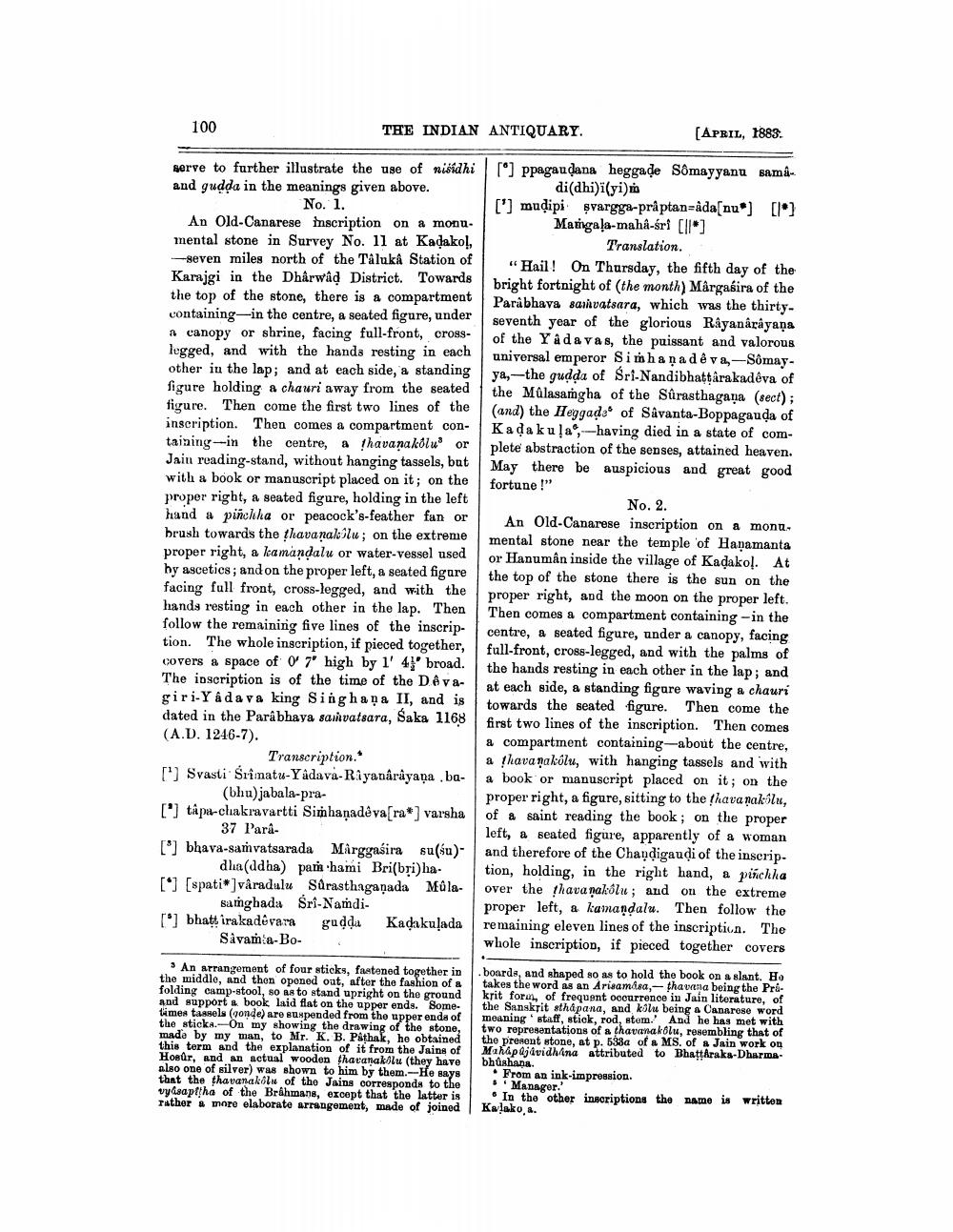________________
100
THE INDIAN ANTIQUARY.
serve to further illustrate the use of nisidhi and gudda in the meanings given above. No. 1.
An Old-Canarese inscription on a monumental stone in Survey No. 11 at Kadakol, -seven miles north of the Tâlukâ Station of Karajgi in the Dharwad District. Towards the top of the stone, there is a compartment containing in the centre, a seated figure, under a canopy or shrine, facing full-front, crosslegged, and with the hands resting in each other in the lap; and at each side, a standing figure holding a chauri away from the seated figure. Then come the first two lines of the inscription. Then comes a compartment containing in the centre, a thavanakolu" or Jain reading-stand, without hanging tassels, but with a book or manuscript placed on it; on the proper right, a seated figure, holding in the left hand a pinchha or peacock's-feather fan or brush towards the thavanakilu; on the extreme proper right, a kamandalu or water-vessel used by ascetics; and on the proper left, a seated figure facing full front, cross-legged, and with the hands resting in each other in the lap. Then follow the remaining five lines of the inscription. The whole inscription, if pieced together, covers a space of 0' 7" high by 1' 4" broad. The inscription is of the time of the Dê vagiri-Yadava king Singhana II, and is dated in the Parâbhaya samvatsara, Saka 1168 (A.D. 1246-7).
Transcription. [] Svasti Srimatu-Yadava-Rayanarayana.ba(bhu) jabala-pra
[] tâpa-chakravartti Simhanadê va[ra*] varsha 37 Parâ
[] bhava-samvatsarada Marggasira su(su) dha(ddha) par hami Bri(bri)ha[*] [spati*]vâradulu Surasthaganada Mulasamghada Sri-Namdi[*] bhatt irakadevara Savam a-Bo
gudda Kadakulada
An arrangement of four sticks, fastened together in the middle, and then opened out, after the fashion of a folding camp-stool, so as to stand upright on the ground and support a book laid flat on the upper ends. Sometimes tassels (gonde) are suspended from the upper ends of the sticks. On my showing the drawing of the stone, made by my man, to Mr. K. B. Pathak, he obtained this term and the explanation of it from the Jains of Hosûr, and an actual wooden thavanakilu (they have also one of silver) was shown to him by them.-He says that the thavanakolu of the Jains corresponds to the vyasaptha of the Brahmans, except that the latter is rather a more elaborate arrangement, made of joined
[APRIL, 1883.
[] ppagauḍana heggade Sômayyanu samâdi(dhi)i(yi)
[] muḍipi svargga-prâptan-âda[nu*] [*] Mangala-maha-sri [*]
Translation.
"Hail! On Thursday, the fifth day of the Parabhava samvatsara, which was the thirtybright fortnight of (the month) Mârgasira of the seventh year of the glorious Râyanarayana of the Yadavas, the puissant and valorous universal emperor Simhanadêva,-Sômayya,-the gudda of Sri-Nandibhaṭṭarakadeva of the Mûlasamgha of the Sûrasthagana (sect); (and) the Heggade of Sâvanta-Boppagauda of Kadakula, having died in a state of complete abstraction of the senses, attained heaven. May there be auspicious and great good
fortune!"
No. 2.
An Old-Canarese inscription on a monumental stone near the temple of Hanamanta or Hanumân inside the village of Kadakol. At the top of the stone there is the sun on the proper right, and the moon on the proper left. Then comes a compartment containing in the centre, a seated figure, under a canopy, facing full-front, cross-legged, and with the palms of the hands resting in each other in the lap; and at each side, a standing figure waving a chauri towards the seated figure. Then come the first two lines of the inscription. Then comes a compartment containing-about the centre, a thavanakolu, with hanging tassels and with a book or manuscript placed on it; on the proper right, a figure, sitting to the thavanakolu, of a saint reading the book; on the proper left, a seated figure, apparently of a woman and therefore of the Chandigaudi of the inscription, holding, in the right hand, a pinchha over the thavanakolu; and on the extreme proper left, a kamandalu. Then follow the remaining eleven lines of the inscription. The whole inscription, if pieced together covers
.boards, and shaped so as to hold the book on a slant. Ho takes the word as an Arisamasa,- thavana being the Prakrit form, of frequent occurrence in Jain literature, of the Sanskrit sthapana, and kilu being a Canarese word meaning staff, stick, rod, stem. And he has met with two representations of a thavanakolu, resembling that of the present stone, at p. 538a of a MS. of a Jain work on Mahapajividhina attributed to Bhattaraka-Dharmabhushana.
From an ink-impression.
Manager.
In the other inscriptions the name is written Kalako, a.




